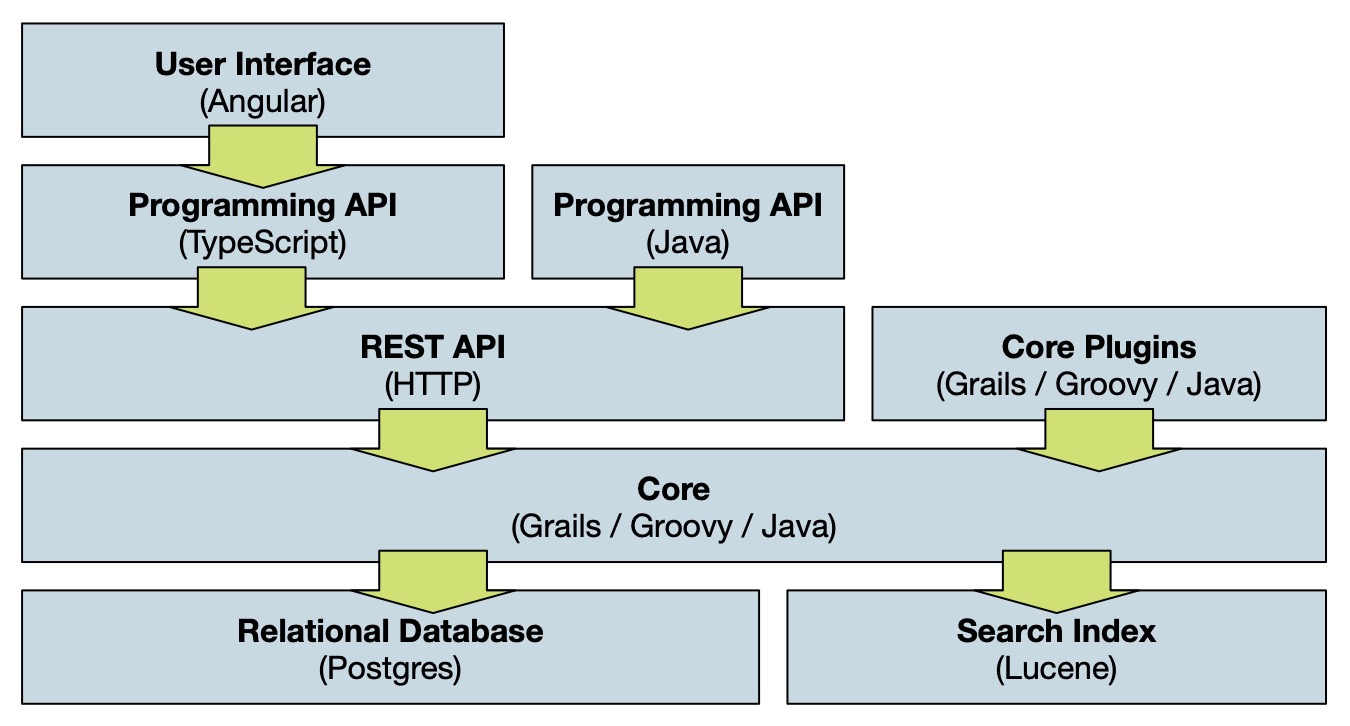Technical Architecture
Overview¶
Mauro Data Mapper is built using a fairly common layered design. At the heart is a standard, relational database where all data is primarily stored.
All interaction with the database is controlled through business logic within the 'Core' layer. Interfaces around the core allow interaction at different levels of abstraction

Relational Database¶
Mauro Data Mapper has been built on top of PostgreSQL and in particular is tried and tested against PostgreSQL version 12. However, we've taken care not to use any clever features or plugins so that the majority of the code should run against any recent version of PostgreSQL.
Furthermore, since the interaction with the relational database is based upon the Hibernate ORM it could even be possible to rebuild against other database implementations, but we've yet to try. The only exception is during integration testing, in which an in-memory h2 database is used in order to speed up testing.
System administrators with access to the database can access the data directly, and this is the preferred route for taking backups. However, editing or interpreting the data directly through the database is not recommended, as this will bypass the business logic in the core, with potential loss of system integrity.
Core¶
The Core component is built using Grails (version 4), which is a Java-based Model-View-Controller framework. Code is typically written in Groovy, which itself compiles down to Java. Much of the Grails framework is built on top of the widely-used Spring components.
The Core codebase defines the object-oriented domain model, which specifies the structure and constraints on the underlying model. All program logic is contained within Services and Controllers, with Views defining the structure of any outputs to procedures or requests.
REST API¶
The REST API is a logical layer, defined completely within the Core component and is the standard way of interacting with the platform. A
standard REST-style interface makes use of standard HTTP commands, for example
GET, POST, PUT, and DELETE. Each REST endpoint is defined by a Controller and View within the Grails
Core. Some endpoints are aliased for ease of use, or backwards compatibility, and there is genericity built in to make programming against the API
easier. Plugins may extend the API with new endpoints.
Each endpoint typically receives and responds in JSON; some can use XML but this is less well tested. Custom data formats apply in particular circumstances - for example when dealing with file attachments.
Programming APIs¶
The programming APIs wrap REST commands in programming constructs to make it easier for programmers to interact with Mauro Data Mapper without being concerned with the technical details of the REST API. Of the three current APIs, the Java library is most mature and is able to re-use components of the Grails Core for a faithful representation of the underlying object model.
The Java API is suitable for programming complex import and export routines and has built in support for a number of batch operations that are not easily achieved through the web user interface. The Java client also supports connections to multiple instances, making it a good tool for implementing more sophisticated federation mechanisms.
The Typescript API is a much simpler wrapper around those endpoints used by the web interface. It is hosted as a separate
component and can be installed using npm, the standard package manager for javascript applications.
User Interface¶
The web-based user interface is defined in Angular 14 using the Angular Material library for look-and-feel. It is a self-contained, single-page web application which makes use of some additional typescript libraries (for rendering diagrams, providing notifications, etc) on top of the standard ones provided by Angular.
It only uses the REST API (via the typescript client library) to communicate with the Core, and is built in a modular fashion to allow easy extensibility. Many of the components can be easily re-used in the creation of other web interfaces.
Grails Plugins¶
The Grails Core provides an easy mechanism for extension, through standard Grails plugins. A number of pre-defined extension points are available. For example, to implement new importers, exporters, profiles, or authentication mechanisms. However plugins may also arbitrarily extend the REST API with custom functionality, making use of the services and controllers defined within the core.
A number of plugins are defined and made available through the central GitHub plugins organisation; developers may feel free to use and adapt those, or write their own, sharing if they wish. Note that some technical plugins such as the SPARQL or Apache Freemarker plugins allow users to perform their own queries against the database and arbitrarily complex queries may affect the performance of the server.
The Core component is itself made up of a number of plugins, and can be disassembled for particular use cases. For example, it is possible to disable support for API Keys by compiling a version of the Core with that plugin removed.
Search Index¶
The search index improves the performance of searching, this content is stored in-memory (and persisted to files on disk at suitable intervals). In some places in the Core, it may also be used to speed up access to particular model contents.
The index is built using Apache Lucene but managed in the code through Hibernate. This means that it is always kept in sync with the database contents, but it can be re-indexed if necessary.
The contents of the search index can be hard to inspect for debugging purposes! We use a tool called Marple but be sure to use a compatible version!